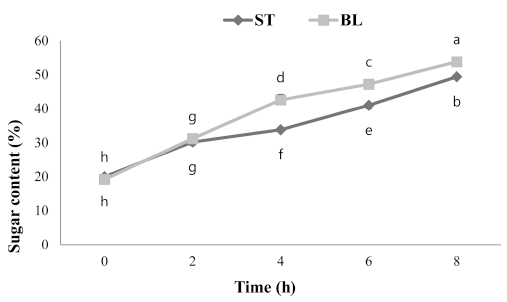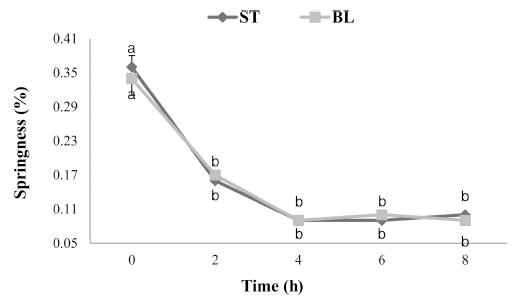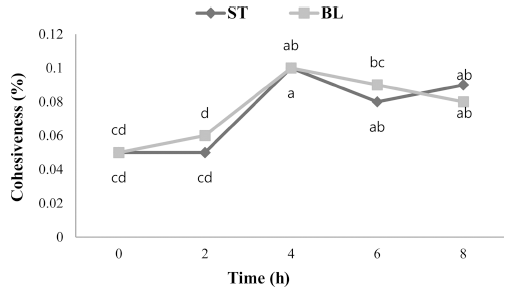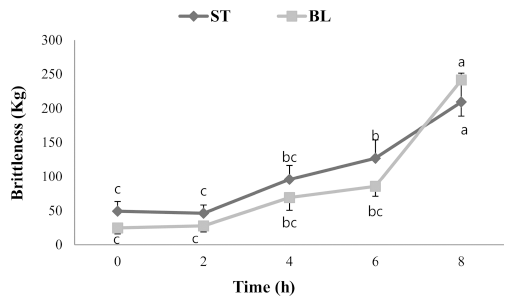Introduction
Sweet potato (Ipomoea batatas L. Lam) is known as one of the most commonly grown food crops after paddy, wheat, potatoes, corn, and cassava (Shekhar et al., 2015). Sweet potatoes play an important role in ensuring food security, especially in developing countries (Lee et al., 2012). Sweet potatoes, in addition to providing sugar, flour, also have natural fiber, vitamins, minerals, and flavonoids (Haile et al., 2015). The nutritional value per 100 g of raw sweet potatoes are water 62.7%; carbohydrates 34.9% (starch 25.0%; sugar 7.1%; diet 2.8); 0.5% fat; 1.0% protein and more vitamins and minerals (NAAS, 2016). The research of Guo et al. (2019) reported that white sweet potato varieties had the highest starch content from 61.5 to 67.5% and the lowest dissolved sugar content was from 13.1 to 18.0% and yellow varieties had the highest starch from 45.8 to 53.1% and the highest soluble sugar is from 28.9 to 31.5%. In particular, during the storage of sweet potato tubers, the starch has been converted into reducing sugar and then into sucrose.
Sweet potatoes are used very popular in the world. Sweet potatoes can be used to eat directly after boiling, or baking and can be processed into semi-finished products (dried sweet potato, sweet potato flour, starch) for utilization as raw materials in other food processing industries such as snacks, noodles, breakfast cereals, bread, desserts or consumed as a soup (Rashid et al., 2019). Today, the demand for using natural products without additives is increasing. Drying is a common technology to process and preserve agricultural products. This technology also creates a valuable product line, which is used simply as a snack (Oh et al., 2017). These products not only provide energy but also provide natural nutrients such as sugar, starch, fiber, pigments. Consequently, it is useful for health and consumption trends will increase in the future. Hot air drying is one of the most common processing method and uses the least energy in drying technologies (Sabarez, 2016).
Currently, ready-to-eat dried sweet potato products with soft structure, high sweetness (sugar content > 40%), high moisture content (20-30%) are very popular in Korea, China, Japan, and Vietnam as snack foods, but major constraint in producing high-quality dried sweet potato is from lack of knowledge on processing technology. The researches on sweet potato processing focused on fried, dried, flour sweet potato products (Xiao et al., 2009;Singh & Pandey, 2012;Yan et al., 2013;Ahn et al., 2013;Haile et al., 2015;Lagnika et al., 2019;Subroto et al., 2019). To produce ready-to-eat dried sweet potato products, the moist-heat pretreatment step is very important. During the heat-moisture treatment, the starch of the sweet potato gelatinized. Some references mentioned that the heat-moisture treatment method may cause some gelatinization or damage of starch granules (Huang et al 2015), resulting in a change in the crystal structure of starch. Starch gelatinization is the result of breaking the intermolecular bonds of starch molecules with the presence of water and heat, allowing hydrogen bonding sites to hold more water. Most starch was converted into dextrin and maltose by the enzymes α-amylase and β-amylase. Whereas, maltose is only produced during cooking (Lewthwaite et al., 1997) and supplies a higher elasticity of cellular composition that raises sweetness (Lagnika et al., 2019). Gelatinization temperature of sweet potato starch is 58-84 °C (Chen et al., 2003). On the other hand, heating in the pretreatment stage prevents the darkening of sweet potato by enzyme (polyphenolic oxidation), because heat inhibits the activity of enzyme polyphenol oxidase. Boiling and steaming are popular heat-moisture treatments methods. Hoover & Vasanthan (1994) showed the effect of moist heat treatment on the structure and physical and chemical properties of cereals, legumes, and tubers depending on the moisture in the heat treatment process and starch source. Thermal pretreatments altered the structure, the quality characteristic, and the water distribution within these materials was reported by Wang et al. Huang et al. (2015) observed the different effects of heat moisture treatment on the structural and digestibility characteristics of sweet potato starch. Nevara et al. (2019) also demonstrated that heat-moisture treatments retain purple, anthocyanin and resistant starch content in dried purple sweet potato flour. Hence, ready-to-eat dried sweet potato slice products may need knowledge on processing technology for better quality. The main goals of this study are to research the effects of moist heat treatment methods prior to drying sweet potato slices and to establish appropriate drying conditions of sweet potato slices
Materials and Methods
Sweet potato (Ipomoea batatas L.) roots were harvested in October 2019 from a local farm in Muan, Korea and were stored at 14 °C until using. Prior to the start of each experiment, sweet potatoes were washed with tap water and peeled with a hand peeler. Then, the samples were cut into slices (1 cm thickness) using a slicing machine.
Sweet potatoes slices were treated as follows: (i) boiling in 45min.; (ii) steaming in 45 min. The boiling and steaming time were selected in a preliminary study on sensory comment.
The treated sweet potato slices were dried at 70 °C by a convection drying oven for 2, 4, 6, 8 h. To compare quality indicators of each other pretreatment methods, the water activity, moisture, sugar content, color, and texture of dried sweet potato products at different drying time were analyzed to select good formulas.
All the experiments were conducted in triplicate and the average values were used for result analyses.
Moisture content of the samples was determined by drying in an oven at 105°C until a constant weight was obtained. The moisture of samples was also calculated following Equation:
Where:
About 4 g sample were prepared for analysis of water activity by using analyzer (Lab. Master aw, Novasina, Lanchen, Switzezland).
Samples (size 1.5 × 1.5 cm) were prepared for analysis of TPA. Samples were punctured using a 5 mm flat-head stainless steel cylindrical probe with a test speed of 200 mm/min, and a distance of 5 mm of texture analysis equipment (Compact - 100, Sun scientific Co., Tokyo, Japan). The fracture toughness was registered as the texture index. The result of the texture test is an average value of 10 times for each sample.
Color of samples were measured by using colorimeter, (Color i7, X-rite Inc, Grand Rapids, MI, USA). Prior to the color measurements, the colorimeter was calibrated using a standard black and white plate. The color indexes were tested base on CIE lightness (L*), redness/greenness (a*), and yellowness/blueness (b*).
Distilled water (30 mL) was added to 5 g sample, and sample dispersion was milled at 10,000 rpm for 1 min using a homogenizer (AM -11, Nihonseiki Kaisha Ltd., Tokyo, Japan). Sugar content was analyzed by refractometer (PAL-3, Atago, Tokyo, Japan). Determination sugar content of samples following equation:
Sugar content = b × 6
Where:
Results and Discussions
Changes in the water activity, moisture content, and sugar content with different pretreatment conditions and drying time during hot air drying of sweet potato sliced at 70 °C are shown in Fig. 1, 2, and 3. It is evident that moisture content and water activity continuously decreased while the amount of sugar increased significantly during drying time. These results were generally in agreement to some document on drying agricultural products (Akpinar et al. 2003;Sablani & Mujumdar, 2007;Bondaruk et al., 2007;Sobukola et al. 2008;Tabtiang et al., 2012).



Fig. 1 illustrated that the water activity of steamed or boiled sweet potato slices was 0.92 and 0.93, respectively. This result is similar to the study of Nevara et al. (2019). The water activity of samples was no significant difference between the two treatments method during the first 4 h of drying time (p<0.5). According to the results in Fig. 1, the drying time from 4 to 8 h had a significant influence on the water activity of the sweet potato slices (p<0.5). The results showed that Aw of dried sweet potato after boiling or steatming continuously decreased with increasing drying time. The final aw of BL and ST samples at 8 h of drying time were 0.81 and 0.82, respectively.
Fig. 2 demonstrated the moisture content of pretreated sweet potato samples at different drying times. The moisture content of boiled sweet potato slices (68.90%) were considerably higher tjan steamed sweet potato slices (62.75%). These results were similar to the report of Shin et al. (2005) amd Nevara et al. (2019). Some references mentioned that heatmoisture treatment may cause gelatinization or other damage of starch particles (Huang et al., 2015). The structure of starch can be changed within amorphous and crystalline regions in the starch granules. Starch gelatinization is the result of breaking the intermolecular bonds of starch molecules with the presence of water and heat, which leads the hydrogen bonding sites to keep more water. Besides, immersion of sweet potato stices in the water (boiling) resulted in greater water gain (Ahn et al., 2013;Huang et al., 2015;Lagnika et al., 2019). Fig. 2 also illustrated that the moisture content of dried sweet potato constantly declined with increasing drying time (Shin & Lee, 2011; Sabazez, 2016). During a drying period of 4 to 6 h, there was no significant difference between boiled and steamed treatment. Then, the moisture content of boiled dried sweet potato slices decreased considerably, around 19.71%, whereas the water amount of steamed dried sweet potato slices was 25.53% after 8 h drying.
Fig. 3 shows that the sugar content of the sweet potato samples rised gradually with increasing drying time. It appears that the starch was broken-down into the sugar during pretreatment (Sablani & Mujumdar, 2007;Shin & Lee, 2011; Sabazez, 2016). The sugar content of boiled and steamed sweet potato was not significantly different during first 2 h drying (p<0.5). The sugar content of sweet potato sample considerably increased compared with boiled that of steamed treatment sample (p<0.5). At the 8 h of drying, the sugar content of the boiled and steamed treatment sweet potato was 53.80 and 49.40%, respectively. This difference between boiled and steamed treatment samples was due to the fast moisture removal rate of the boiled sweet potato sample, so increasing the number of soluble solids in the dried product.
Table 1 illustrated the results of the color measurement of sweet potato. After heat treatment, the lightness (L*) index of samples is a significant different (p<0.5) showing 65.13 and 69.75 for BL and ST samples, respectively, as reported by Nevara et al. (2019). The L* values of boiled sweet potato are higher than steamed samples. Because the hydrogen peroxide formation during boiling that is responsible for the browning reaction. Besides, the reduced moisture content on the surface of the sweet potato slices enhanced reflectivity of the samples which made the L* value of samples tended to decrease constantly. The redness (a*) and the yellowness (b*) values of all samples tended to gradually increase as drying time increased. The L* of ST samples declined from 65.13 to 52.56, the a* rose from -3.07 to 3.89, and the b* also increased from 28.34 to 37.72. Whereas the L* of BL samples dropped from 69.75 to 54.88, the a* climbed from -4.18 to 6.17, and the b* grew from 30.75 to 38.23. The results showed that the color of BL pretreatment samples changed more than that of ST pretreatment samples but no significant difference (p<0.5) as suggested by Nevara et al. (2019). The change in the brightness redness, and yellowness of the dried sweet potato were caused by drying. This result could be explained by the effect of the Maillard reaction and caramelization due to the sugar of sweet potato when drying at high temperatures (70 °C) (Lagnika, 2019).
One of the most important quality attributes affecting the acceptability of processed foods is texture. Parameters of texture is an index to assess for the mouthfeel of dried products that correlate to customer’s pleasing. Texture profile analysis of the samples was measured by a texture analyzer which is shown in Fig. 4, 5, 6, 7, and Fig. 8 These figures demonstrated that there was no different significant (p<0.05) of the springi-ness, cohesiveness, gumminess, brittleness parameters unless hardness values between pretreatment conditions of samples in the same drying time. Similar observations were reported by Shin & Lee (2011) and Onwude et al. (2018).





Fig. 4 illustrated the springiness of sweet potato samples trend to decline and there were only significantly difference for the first 2 h drying time (p<0.05). The springiness values were 0.36, 0.16, 0.1 % for ST samples while BL samples were 0.34, 0.17, 0.09 % at 0, 2, 8 h drying time, respectively.
Fig. 5 indicated slight fluctuation of the cohesiveness of sweet potato slices after treatment and drying for 8 h. During drying time from 0 to 4 h, the cohesiveness of ST and BL were similar, increasing from 0.05 to 0.10 %. Then, it was light fluctuation at the time of 8 h of drying and the cohesiveness of ST and BL were 0.10 and 0.08 %.
Fig. 6, Fig. 7 gave information about the gumminess and brittleness of the BL and ST sweet potato samples. The results showed that the gumminess and brittleness values of ST samples were no higher significantly different than BL samples during 6 h of drying time (p<0.05). After about 7 h of drying, the both of gumminess and brittleness of BL samples rose higher than ST samples but no difference significantly (p<0.05). The gumminess of ST and BL sweet potato trials were 0.15, 1.36, 2.22 kg and 0.07, 0.96, 2.72 kg at 0, 6, 8 h of drying, respectively. The brittleness of ST and BL sweet potato samples were 49.25, 126.90, 209.38 kg and 24.86, 85.6, 241.44 kg at 0, 6, 8 h of drying, respectively.
Fig. 8 provided information about the hardness of sweet potato slices. Overall, the hardness of samples gradually climbed and significantly different between the BL and ST samples during drying time.
At the same time (the first 2 h drying), the hardness fell minimally and no significantly different (p<0.05), around 6.86, 6.00 kg/cm 2 for ST and BL, respectively. Then, the hardness of sweet potato samples considerably increased (p<0.05) during drying and the hardness of ST patterns was higher than that of BL samples. The hardness values were 15.86, 22.72, 31.98 kg/ cm 2 for ST samples and 9.09, 14.48, 20.49 kg/cm 2 for BL samples at 4, 6, 8 h of drying time, respectively.
Conclusion
Overall, boiling or steaming prior to hot air drying successfully tackles processing dried sweet potato for the use of a snack food. This study showed that the different pretreatment methods had different effects on the quality characteristic of dried sweet potato slices product. Boiling sweet potatoes before hot air drying has significantly lower water activity, moisture and hardness of the final product, and the sugar content is significantly higher than that of steaming. Among the color, springiness, cohesiveness, gumminess, and brittleness, brittleness index were not significantly different at 70 °C, 8 h drying. Such information is useful not only for the producer but also for manufacturers to produce snack dried sweet potato slices. These findings provided the feasibility of heat-moist treatments to produce a dried sweet potato.